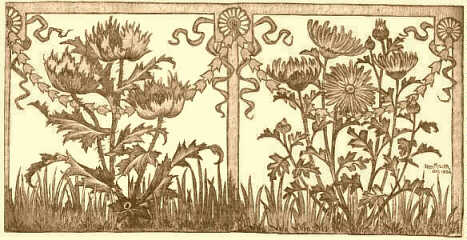
PIANOFORTE FRONTS: AND HOW TO DECORATE THEM
By FRED MILLER
The Girl's Own Paper (July 4, 1885)

There are few places in a room that better repay the time spent upon beautifying them than pianoforte fronts, viz., that part which in many pianos is occupied by fretwork and pleated silk. It is a capital situation for putting in a little nice decoration, for whatever is placed there is seen to great advantage. The first thing to be done towards decorating this part of the piano is to carefully measure the opening that receives the fretwork, and it may be necessary to remove this fretwork to take the size accurately, though this is not often the case. The pleated silk is often stretched over a light framework of wood, and where this is the case the old silk can be removed and the painted silk tacked on to the existing framework. In some cases the silk is tacked on to the framework of the piano, and it is perhaps hardly necessary to have a framework made, as the silk to replace the old front can likewise be tacked on the framework when finished. There must be sufficient silk to allow of its being turned over and round. Some of the fine coloured satins, such as those used for embroidering, will be found to be a very suitable material for painting on if you decide to paint the design. The Adolfi medium mentioned in my hints on painting a mantel border is the vehicle I recommend for using with the ordinary oil colours in tubes. This medium dries quickly, and as it makes the colour elastic, there is little danger of the paint cracking or peeling off. You use the medium as you would turpentine to dilute the colours, the plan of painting the lights on thickly, and the darks on thinly, so that the material shows through, as I advocated in the case of plush or velvet, maybe resorted to in the case of silk or satin. The colours need not in any case be painted on very thickly, as very little body of colour is required to cover, and the less thickness of colour there is upon the silk the better chance there is of the colour standing. Peacock blues and greens, olive green, and old gold are effective colours for painting on, though I give the preference to dark colours as the painting is so much more effective on a dark than on a light ground. Old gold is more difficult to treat, as certain tones of green are not effective upon it, and being, as it is, a sort of middle tint between dark and light, unless some care be exercised much of the work painted upon it is apt to be lost.
When the design has been painted the bronze colours may be employed to complete the effect, and an outline of gold would enrich the design. The festoon at back of flowers might be put in wholly in gold, so also might the lines which divide the space up into panels.
In addition to the gold outline, the flowers and leaves might be finished with touches of the bronze colours.
This design might also be effectively worked in crewels or silk, and a little gold thread might be introduced. The leaves should be worked in crewels of good substance, with good bold stitches, and the flowers in silk. The festoon at back might be just outlined in gold-coloured silk, or with gold thread, together with the dividing lines, though, of course, there is no reason why these ornamental features should not be omitted should it be thought that the work is sufficiently effective without them.
The plants chosen - the daffodil, iris, poppy, and chrysanthemum - are so familiar to all my readers that I feel sure they will have little difficulty in enlarging and carrying out the design should they feel so disposed. The plants are slightly conventionalised, so as to simplify them for working, and by panelling out the space, and introducing the festoon at back of flowers, a certain "oneness" and completeness is given to the design, which perhaps would be lacking were the flowers merely placed on the silk at regular intervals with nothing to bind them together and make them one.
There are plenty of decorative schemes besides of the one given that would make effective pianoforte fronts. A head of some great musician, supported on either side by foliage or cupids; or cupids holding a medallion of a musician; or, again, cupids playing on musical instruments, with flowers and butterflies; or again, a field of flowers with birds and butterflies suggest themselves to everyone, and only want to be carried out to be effective.
The backs off cottage pianos are also capital places to decorate, more especially as it is the custom in many homes to have the piano standing in the room with the back exposed to view. With your Editor's kind permission, I shall give in another number a design for the back of a pianoforte, and shall then have something more to say about it.
Be careful to make the colours harmonise with the ground, especially in the case of paintings upon silk or satin. The darker the colour of the ground the greater the need of care to avoid crudity, as a comparatively low-tone colour on the palette will look quite crude and harsh on the dark silk. Make the greens of yellows toned with burnt and raw sienna, and use indigo for dark greens rather than Antwerp blue. Antwerp blue always requires toning with burnt sienna or other warm colour when mixed with yellow. Cobalt and yellow ochre make good grey greens with white.